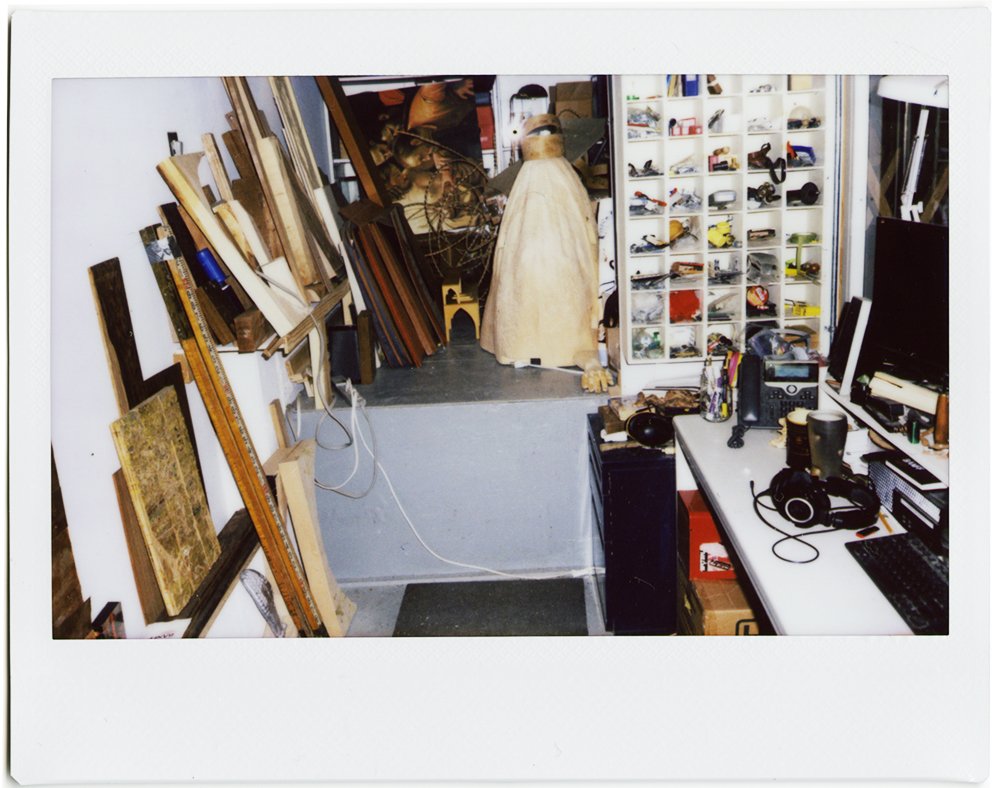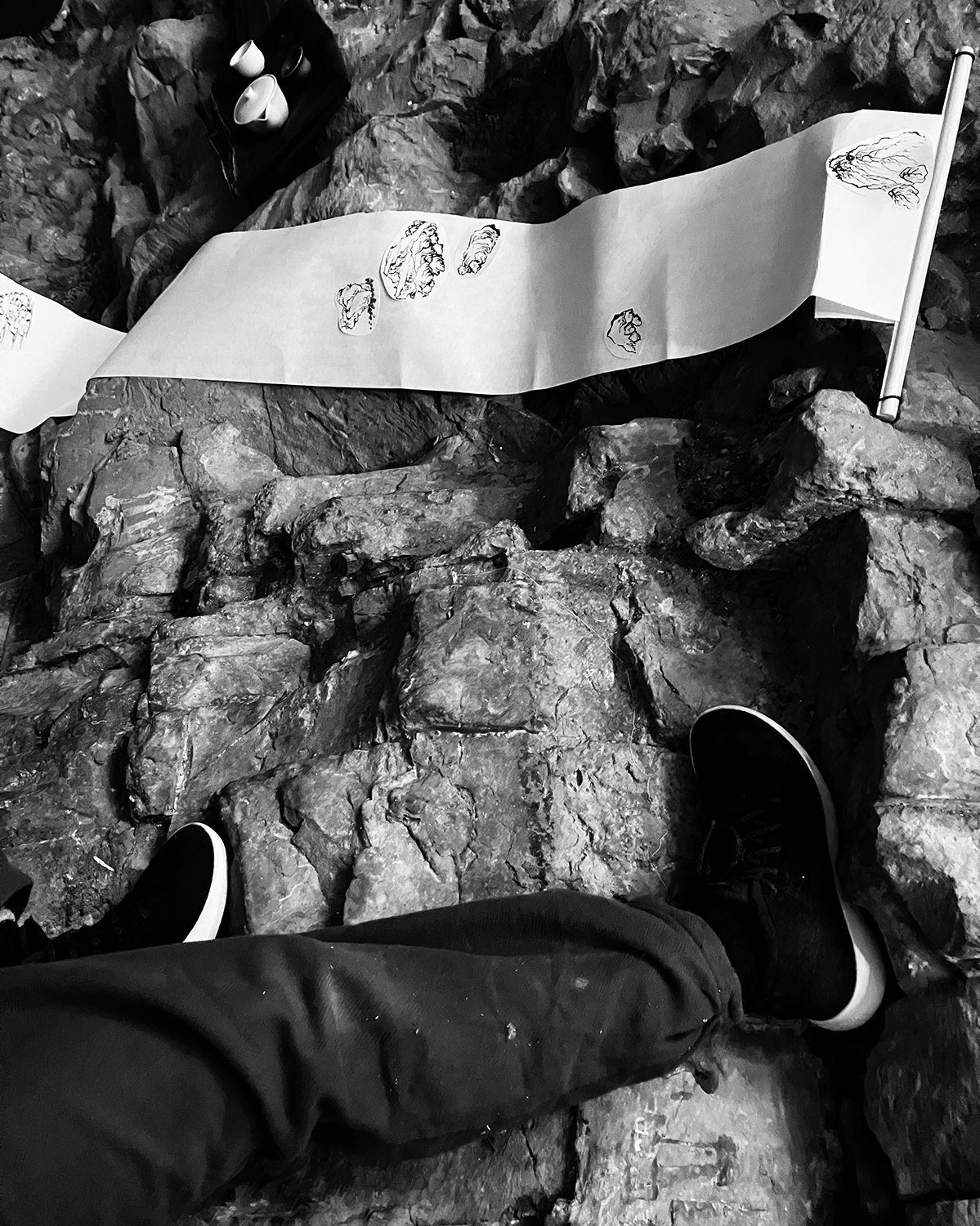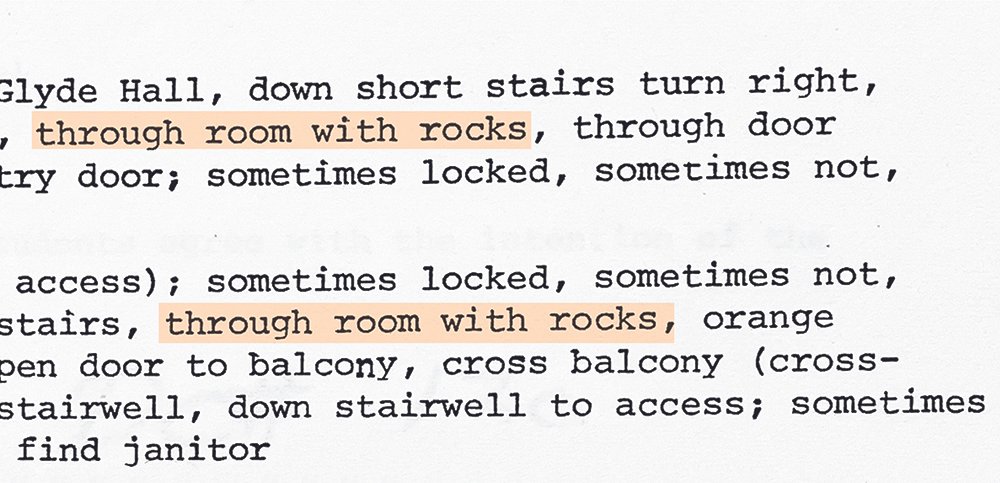MOUNTAIN ENTERS ROOM
project initiated during the Meeting For Teas Visual Arts residency, Banff Centre for Arts and Creativity, August/September 002023
PART ONE:
Sacred Guardian Buffalo Mountain surfaces within Banff Centre campus buildings, behind closed doors, under tables, through forgotten rooms, under plywood boxes and runs alongside infrastructural pipes. MOUNTAIN ENTERS ROOM respectfully addresses the Mountain, and its continuum, as a dynamic, structural space for sharing tea — a planetary tea room.
An honorific cup of gyokuro tea (山下玉露*), served from a teacup reserved for non-humans, is poured across the 300-million-year-old interior outcroppings of Sacred Buffalo Guardian Mountain. The practice focuses human attention towards larger, living and continuously changing geologic forces beneath and around us, and the long, planetary futures yet to come. It also celebrates the assemblage of human and non-human forces present at the site (such as, mountain, tea, humans, utensils, water and time).
A photo is taken at each of nine sites of interior outcroppings as tea is poured. Each outcropping appears as it co-exists alongside the ephemeral lives and practices of humans in 002023. Rather than photography that captures or “represents” the mountain as knowable, or a contained/enclosed entity, the collection of snapshot images suggest that the mountain’s ongoing presence is distributed, wide and vast extending under and through the Banff Centre’s campus — and far beyond. The Rocky Mountains stretch for 3,000 miles from western Canada to New Mexico, and predate human habitation of the land. They cannot be captured or fully known.
Collectively, the resulting images suggest a dream-like subconscious planetary knowing, and vast spatial distribution through space and time.
INTERIOR OUTCROPPINGS / TEA EVENT SITES:
THURSDAY, August 24th, 002023 2-4:30PM MT
1_Papermaking area in Glyde Hall basement
The space was smudged in advance by Heather Shillinglaw
This was the only tea event staged directly upon the mountain surface where we (smudge studio) also drank tea (Yamashita’s Takumi gyokuro). The tea practice considered the interior outcropping as the honored “first guest” and as central to the day’s tea event. This tea event also focused on the challenges that exposed geologic surfaces present to human navigation. We adapted and slowed our movements to the uneven contours. We addressed the dynamic geologic surfaces as a planetary structure for tea, activating the nooks and crannies of the raw, exposed geology as affordances for tea preparation and sharing. As we offered warm water, and then tea, to the outcropping, a strong scent of moistened rock/earth immediately filled the space around us.
WEDNESDAY, August 30th, 002023 2-3PM MT
The following eight sites were visited over the course of one hour as a continuous and mobile tea event, connecting the interior outcroppings of the mountain across campus.
Tea: Yamashita’s Shuppin gyokuro.
2 Entry to mechanical room and crawl space, Glyde Hall
3 Crawl space entry door, Papermaking, Glyde Hall
4 Spray booth in Glyde Hall Sculpture Shop
5 Welding Room in Glyde Hall Sculpture Shop
6 Basement of Theatre
7 Storage area of The Club, Theatre Bldg.
8 Basement of Lloyd Hall
9 Basement of Sally Borden
TUESDAY, August 29th, 002023 2PM MT
10 No tea. Photography only, plywood box over mountain in Sculpture Shop office
_____
The tea events took place during the worst fire season on record in Canada. The Air Quality Index in Banff on August 24, 002023 ranged from 60-112 PM2.5 and on August 30th, 002023 ranged from 65-95 PM 2.5. August 24th, 002023 was also the first day of a decades-long process by which treated radioactive wastewater from the Fukushima Daiichi nuclear power plant will be released into the Pacific Ocean.
* 山下玉露 is a shade grown tea from Japan. 山下 is a family name for one of Japan’s most revered gyokuro growers and translates as “under mountain.”
THANK YOU to Mark Fuller, Facilities Manager at the Banff Centre for his generosity of knowledge and time, Heather Shillinglaw for smudging in advance of the first tea event + Paul Hickling and Wendy Tokaryk for their research support.
MOUNTAIN ENTERS ROOM ARTIST BOOK
20-page, risograph, side-stapled artist book
10” x 4.25”
Edition of 40, 002025
$20 + shipping ($10 domestic/$20 international)
_______
PART TWO
ONGOING RESEARCH PRACTICE
How might humans address and design with the geologic, throughout the process of architectural construction, and in the particular case of the Banff Centre, while literally inhabiting shared physical space?
Architects and engineers have specific ways of imagining, visualizing and materially shaping the interface between humans and the planet via the built environment — physical walls, doors, passageways and ideas of interior/exterior, "inside" and "outside". These interactive relationships, how they are expressed and lived, convey immense social, political, material, environmental — and spiritual — consequence.
In the midst of intense, human-induced, environmental change these lively interactions offer vital insights regarding how we have arrived, and might respond to, our shared moment of geologic (Anthropocene), planetary history.
While in residence at Banff, we spent time in the library archives searching for references to the interior outcroppings as well as architectural plans that visualized the Mountain as it is literally present, inside the campus buildings. The research continues and initial documents shared here date to the late 1970s when the Arts Studio, where the current papermaking space and largest interior outcropping is located, was renovated and renamed Glyde Hall.
In attempt to expand and illustrate the nuanced and personal awareness many humans currently have with/of the Mountain, we invited staff at the Banff Centre, and Meeting For Teas residency Faculty and participants, to share reflections and observations about what it is like for them to work near, and spend time in proximity to, the interior outcroppings of Sacred Guardian Buffalo Mountain:
Okotoks, rock in Blackfoot, are an integral part of Blackfoot world view, they are the grandfathers who hold the wisdom of the earth, past, present and future. Over the many years of being on Sacred Buffalo Mountain and noticing the interior mountain rock outcroppings around the centre, they give me solace, it is like the grandfathers are looking in on us. They remind us that they/we are just a small part of the bigger picture. Our connection to the land. They continue to bear witness to the passing of time and will be here, long after we are gone, a little bit of us is now etched in their memory. We are elements of this earth and of the cosmos, stardust that continues to shape shift through time, we continuously become something else… — Adrian Stimson - Apoiskumapi/Little brown boy
___
My experience working on the side of the mountain has provided me with many opportunities for grounding. I view the outcroppings of rock among the architecture as resisting the institution. I find myself particularly drawn to the papermaking studio and often sit in silence with the mountain; my hand on the cool rock and eyes tracing the jagged seams of where the white walls meet the mountain.
I am interested in the tension that the asymmetrical and nonlinear can bring to colonial expectations of space, language, objects, and installation. For the outcroppings, it almost feels like the mountain is intruding, occupying volumetric space in a way that we’re not used to. To me, the crags feel poetically out of place yet deeply belong in these constructed spaces.
Reframing interiors.
Reframing focus.
Beacons of energy.
Assertions of agency.
— Chloe Kinsella, Production Manager, Artist Support
___
One half of the Papermaking studio was hidden behind a wall. The evidence for this is a distinct groove in the cement floor, an “L” shape, that follows the support pillar and takes a sharp right angle towards the south wall. I have always been curious to know the history of this space: when and why was the wall first erected and then eventually removed? Glyde Hall was officially opened August 3rd, 1976. The removal of the wall revealed the sculptural presence of the natural rock, that is part of the mountainside. The visible out cropping of limestone elicits plenty of reactions from artists and guests. Over many decades, the stage surrounding this rockface has been used for performances, and the rock itself for castings, photographic backdrops, and numerous interventions. It has curated it own collaborations by attracting the curiosity of artists. It has a quiet presence and is a constant reminder of the primordial space dust that created the universe, planets, and a foundation for creation.
—Wendy Tokaryk, Printmaking & Papermaking Facilitator
___
How strange to encounter the Sacred Buffalo Guardian Mountain, albeit only part of it, a section of exposed solid rock, a perfect platform for a tea ceremony, as the actual substrata of the Banff Centre for the Creative Arts. The newer buildings of the Centre feature a diverse array of composite rock, comprised of stone, plastic, concrete and putty and stone-like panels that strive for the real in both appearance and texture. The exposed section of Sacred Buffalo Guardian Mountain is so visually alarming, simply because it is not a faux support surface. Rather it is part of a whole which is in itself a monument for Indigenous people. Let us imagine though a future wherein we have achieved freedom and the vast majority of people recognize Sacred Buffalo Guardian Mountain and other sites as monuments, to be revered. Before Columbus many Indigenous communities acknowledged land monuments of varying sized and complexities. Every memory stick or stone will tell you that the main practical function of a memory stick or stone is to remember only a tiny amount of the story that should be remembered. Let me remember with fresh eyes when the monument is exposed as a support surface for our art activities. — Wayne Baerwaldt
___
I think the mountain outcroppings in the Centre’s buildings are special to me because I encounter them so rarely in my role. Their presence is an interruption of my day to day movement through work spaces which acts as a strong reminder of where I am and why I came here. They invite me to slow down, take notice of my surroundings and appreciate how I am in their presence, molding to their space and not the other way around. I wonder if I encountered them everyday if I’d feel the same way, but I’m happy for them to remain special so that I never take these mountains for granted. — Jess Brenders, Senior Program Delivery Specialist
___
Truthfully, I do not have very much interaction with the outcroppings on campus due to where my office is located. In fact, I was not even aware of their existence prior to this project. However, what fascinated me most about these outcroppings was their relative absence from our archival materials. While there were occasional mentions to them, I found the lack of substantial commentary on their presence to be a little disappointing.
I think there is a tendency in documenting construction and development projects to focus on capturing the quantitative aspects of a process. Justifiably, things like building dimensions, raw materials, labour costs, and funding sources are crucial information to preserve. However, the qualitative aspects of these projects are needed to understand the full scope of what these spaces actually mean to those who built and interacted with them.
Whether it was out of desire or necessity, these outcroppings exist across Banff Centre. Conversations about these outcroppings were almost certainly held, but they never made it to the archives. — Paul Hickling, MLIS, Archivist, Paul D. Fleck Library & Archives
_______
The work was also on exhbit as a window installation at SPACE Gallery, Portland, ME, October/November 002023.
Photo by Carolyn Wachnicki for SPACE Gallery





































